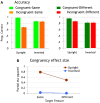Local discriminability determines the strength of holistic processing for faces in the fusiform face area
- PMID: 23316180
- PMCID: PMC3539162
- DOI: 10.3389/fpsyg.2012.00604
Local discriminability determines the strength of holistic processing for faces in the fusiform face area
Abstract
Recent evidence suggests that the Fusiform Face Area (FFA) is not exclusively dedicated to the interactive processing of face features, but also contains neurons sensitive to local features. This suggests the existence of both interactive and local processing modes, consistent with recent behavioral findings that the strength of interactive feature processing (IFP) engages most strongly when similar features need to be disambiguated. Here we address whether the engagement of the FFA into interactive versus featural representational modes is governed by local feature discriminability. We scanned human participants while they matched target features within face pairs, independently of the context of distracter features. IFP was operationalized as the failure to match the target without being distracted by distracter features. Picture-plane inversion was used to disrupt IFP while preserving input properties. We found that FFA activation was comparably strong, irrespective of whether similar target features were embedded in dissimilar contexts(i.e., inducing robust IFP) or dissimilar target features were embedded in the same context (i.e., engaging local processing). Second, inversion decreased FFA activation to faces most robustly when similar target features were embedded in dissimilar contexts, indicating that FFA engages into IFP mainly when features cannot be disambiguated at a local level. Third, by means of Spearman rank correlation tests, we show that the local processing of feature differences in the FFA is supported to a large extent by the Occipital Face Area, the Lateral Occipital Complex, and early visual cortex, suggesting that these regions encode the local aspects of face information. The present findings confirm the co-existence of holistic and featural representations in the FFA. Furthermore, they establish FFA as the main contributor to the featural/holistic representational mode switches determined by local discriminability.
Keywords: FFA; face perception; feature discriminability; holistic; interactive.
Figures




Similar articles
-
From coarse to fine: Interactive feature processing precedes local feature analysis in human face perception.Biol Psychol. 2018 Oct;138:1-10. doi: 10.1016/j.biopsycho.2018.07.009. Epub 2018 Aug 1. Biol Psychol. 2018. PMID: 30076873
-
The discriminability of local cues determines the strength of holistic face processing.Vision Res. 2012 Jul 1;64:17-22. doi: 10.1016/j.visres.2012.04.022. Epub 2012 May 18. Vision Res. 2012. PMID: 22613193
-
FFA and OFA Encode Distinct Types of Face Identity Information.J Neurosci. 2021 Mar 3;41(9):1952-1969. doi: 10.1523/JNEUROSCI.1449-20.2020. Epub 2021 Jan 15. J Neurosci. 2021. PMID: 33452225 Free PMC article.
-
The fusiform face area: a cortical region specialized for the perception of faces.Philos Trans R Soc Lond B Biol Sci. 2006 Dec 29;361(1476):2109-28. doi: 10.1098/rstb.2006.1934. Philos Trans R Soc Lond B Biol Sci. 2006. PMID: 17118927 Free PMC article. Review.
-
Why does picture-plane inversion sometimes dissociate perception of features and spacing in faces, and sometimes not? Toward a new theory of holistic processing.Psychon Bull Rev. 2009 Oct;16(5):778-97. doi: 10.3758/PBR.16.5.778. Psychon Bull Rev. 2009. PMID: 19815781 Review.
Cited by
-
Contributions of low- and high-level contextual mechanisms to human face perception.PLoS One. 2023 May 2;18(5):e0285255. doi: 10.1371/journal.pone.0285255. eCollection 2023. PLoS One. 2023. PMID: 37130144 Free PMC article.
-
The nature of holistic processing in face and object recognition: current opinions.Front Psychol. 2014 Jan 24;5:3. doi: 10.3389/fpsyg.2014.00003. eCollection 2014. Front Psychol. 2014. PMID: 24478737 Free PMC article. No abstract available.
-
Measuring the Contributions of Perceptual and Attentional Processes in the Complete Composite Face Paradigm.Vision (Basel). 2023 Nov 17;7(4):76. doi: 10.3390/vision7040076. Vision (Basel). 2023. PMID: 37987296 Free PMC article.
-
MEG Adaptation Resolves the Spatiotemporal Characteristics of Face-Sensitive Brain Responses.J Neurosci. 2015 Nov 11;35(45):15088-96. doi: 10.1523/JNEUROSCI.2090-15.2015. J Neurosci. 2015. PMID: 26558780 Free PMC article.
References
LinkOut - more resources
Full Text Sources
Other Literature Sources

